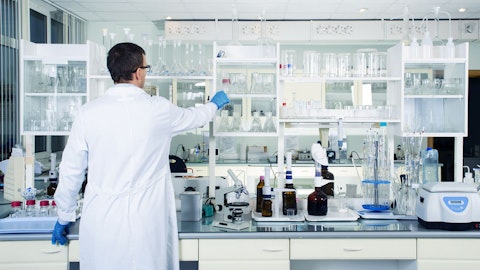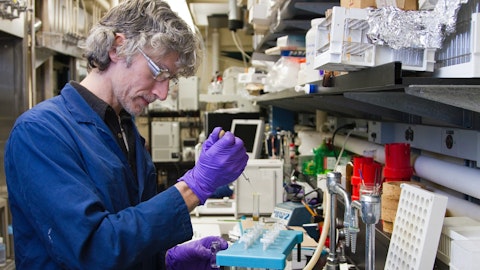Stepan Company (NYSE:SCL) Q4 2022 Earnings Call Transcript February 16, 2023
Operator: Good day, and thank you for standing by. Welcome to the Stepan’s Fourth Quarter and Full Year Earnings Conference Call. At this time, all participants are in listen-only mode. After the speaker’s presentation, there will be a question-and-answer session. Please be advised that today’s conference call is being recorded. I would now like to turn the conference over to your speaker today, Luis Rojo, Vice President and Chief Financial Officer. Please go ahead.
Luis Rojo: Good morning, and thank you for joining Stepan Company’s fourth quarter and full year 2022 financial review. Before we begin, please note that information in this conference call contains forward-looking statements, which are not historical facts. These statements involve risks and uncertainties that could cause actual results to differ materially, including, but not limited to prospects for our foreign operations, global and regional economic conditions and factors detailed in our Securities and Exchange Commission filings. Whether you’re joining us online or over the phone, we encourage you to review the investor slide presentation, which we have made available at www.stepan.com under the Investors section of our website.
We made these slides available at approximately the same time as when the earnings release is issued. And we hope that you find the information and perspective helpful. With that, I would like to turn the call over to Mr. Scott Behrens, our President and Chief Executive Officer.
Scott Behrens: Good morning, and thank you all for joining us today to discuss our fourth quarter and full year results. To begin, I will share our fourth quarter and full year highlights and strategy outlook, while Luis will provide additional details on our financial results. Despite significant external supply chain challenges in a difficult macro environment, the business was able to deliver another record year, significant inflation and raw materials, logistics and other expenses were fully offset with pricing actions, mix improvements and productivity efforts. Improved product and customer mix increased revenue by 30% in 2022, after delivering 22% growth in 2021 Surfactant’s operating income was down slightly, primarily due to lower global commodity laundry demands, raw material constraints and customer inventory to stocking.
Higher demand for products sold under the functional product and institutional cleaning end markets partially offset the above. Polymer operating income increased 13% versus prior year despite lower global sales volume due to customer and channel inventory destocking, reduced construction industry activity and general economic concerns. Specialty Products delivered record operating income of $30 million, compared to $14 million in the prior year driven by improved margin and customer mix. Our Board of Directors declared a quarterly cash dividend on Stepan’s common stock of $0.0365 per share payable on March 15, 2023. Stepan has paid and increased its dividend for 55 consecutive years. During the fourth quarter of 2022, the company paid $8.1 million of dividends to shareholders and repurchase $2.7 million of the company’s stock.
For the full year, the company paid $30.6 million in dividends and repurchase $25 million of company stock. The company has $125 million remaining under the share repurchase program authorized by Board of Directors. We remain confident in the strength and diversity of our business. And its ability to generate cash that will allow us to invest in our current business, pursue strategic M&A opportunities and return cash to our shareholders. Luis, will now share some details about our fourth quarter and full year results.
Luis Rojo: Thank you, Scott. My comments will generally follow the slide presentation. Let us start with a slide five to recap the quarter. Adjusted net income was $13.5 million or $0.59 per diluted share versus $22.5 million or $0.97 per diluted share for the fourth quarter of 2021. Because adjusted net income is a non-GAAP measure, we provide full reconciliations to the comparable GAAP measures, and these can be found in Appendix II of the presentation and table two of the press release. Specifically, the adjusted net income for the fourth quarter, exclude deferred compensation expense of $2.2 million, compared to last year expense of $2.4 million. It also excludes the minor changes in our environmental remediation we serve and restructuring expenses.
The deferred compensation figures represent the net income related to the company’s deferred compensation plan as well as cash-settled stock appreciation for our employees. Because these liabilities change with the movement in the stock price, we exclude this item from operational discussion. The slide 6 shows the total company’s net income bridge for the fourth quarter, compared to last year fourth quarter and breaks down the increase in adjusted net income. Because this is net income, the figure is not here at on an after-tax basis. We will cover this segment in more detail, but to summarize, we delivered excellent operating income growth in a specialty products and lower operating result for Surfactants and some Polymers. Corporate and all other expenses, which are not allocated to the business segment, went up $5.4 million, driven by higher interest expenses and overall inflation.
The company effective tax rate for the quarter was slightly negative, may lead you to one-time favorable tax benefits. The slide 7, focus on the Surfactant segment results for the quarter. Surfactant net sales were $455 million, for the quarter and 8% increase versus the prior year. Selling prices went up 26%, mainly due to the pass-through of higher raw material and logistic costs as well as improved product and customer mix. Volume declined 15% year-over-year, primarily due to lower demand in commodity laundry and personal care and market. Lower volumes due to the transition of Low 1,4-Dioxane capabilities and Polymer inventory probability the stocking efforts. Higher global demand for products sold in the agricultural volumes, institutional cleaning and market partially offset the above.
Foreign currency translation negatively impacted net sales by 3%. Surfactant’s operating income for the quarter was $22 million, a decrease of $11 million versus the prior year. But even by a volume decline of 15% like mentioned it before, and higher expenses associated with a company transition of Low 1,4-Dioxane products. All Surfactant operating ratios are decrease operating income primarily due to the lower volumes mentioned before. Now, turning to Polymer on slide 8, net sales were $148 million for the quarter, a 15% increase versus prior year. Selling prices increased 14% mainly due to the pass-through of higher raw material cost. Global volume declined by 23%, primarily due to a 21% volume declining volumes and lower demand across a Specialty Products and PA businesses.
The decrease was driven by customer inventory destocking, reduced construction, industry activity, and general economic concerns. Foreign currency translation negatively impacted net sales by 6%. Polymer operating income was $3 million versus $30 million in the prior year. The decrease is primarily due to the 23% decline in global volume and higher costs associated with the planned maintenance activities in the company’s PA plant located in the US. North America and Europe results were impacted by lower volume across all polymer segments, partially offset by margin recovery efforts. Asia results improve on increase demand following the eased of COVID lockdowns and restrictions in China. Finally, Specialty Products operating income was $6.6 million versus $2 million in the prior year.

Photo by Daiga Ellaby on Unsplash
This increase was primarily due to improve margins and customer mix within the — product line. Turning to slide nine, despite significant external supply chain challenges and a difficult macro environment, the business was able to deliver another record full year. Adjusted net income was a record $153.5 million or $6.65 per diluted share, a 7% increase versus $143.5 million, or $6.16 per diluted share in 2021. The company volume declined 7% versus the prior year, driven by lower demand as customer inventory destocking efforts in the second half of the year. The Surfactant segment delivered operating income of $163 million, down slightly versus the prior year. Surfactant global volume was down 6%, primarily due to lower global commodity laundry demand, the impact of the and customer inventory destocking efforts.
Higher demand for products sold in the Functional Products and Institutional Cleaning end market partially offset the above. The Polymer segment delivered $83 million of operating income, up 13% versus the prior year. Global Polymer volume declined 7% versus the prior year due to costumer and channel inventory destocking and lower construction-related activities in the second half of the year. Specialty Product operating income was a record $30 million versus $14 million in the prior year, driven by improved margins and customer needs in our product line. Lastly, the effect of foreign currency translation negatively impacted net income by $5.6 million or $0.24 per diluted share versus the prior year. Earnings Per Share excluding FX grew 12% versus 2021.
Slide 10 shows the total company earnings split for the full year of 2022 compared to 2021 and breakdown the increase in adjusted net income. Surfactant was a slightly down more than offset by Polymers and Specialty Products. The company full year effective tax rate was 22% in 2022 versus 20% in 2021. This year-over-year increase was primarily due to non-recurring favorable tax benefits recognized in 2021. Moving onto slide 11, our balance sheet remains strong, and we have ample liquidity to invest in the business. Even with our increased CapEx investments, our leverage and interest coverage ratios continued a very healthy levels. During the year, cash from operations was $161 million and we deployed $466 million against CapEx investments, dividends and debt payments, share repurchases, and higher working capital requirements due to raw material inflation.
The company full year capital spending was $302 million, inclusive of our 1,4-dioxane project and Pasadena investments in the US. Now beginning on Slide 12, Scott will update you on our strategic priorities.
Scott Behrens: Thank you, Luis. In addition to delivering another record year of earnings, we made good progress on advancing our strategic priorities in 2022. The following slides capture our strategic priorities and a vision for a cleaner, healthier and more energy efficient world with our customers preferences in mind. Our diversification strategy and the functional products, including agricultural and oilfield chemicals continues to be a key priority for Stepan. Our global agricultural volumes increased double digits in 2022, supported by high commodity prices for corn, soybean and wheat, which incentivize growers to utilize the full breadth of crop protection options. In addition, Brazil continues to advance in agronomic practices, while favorable weather patterns in Australia increased demand for crop protection.
We continue with the build out of the Kymco KMCO Oilfield Demulsifier product line, having commercialized over half of the acquired product portfolio to date. We remain optimistic about future opportunities in this business as elevated crude prices should encourage increased oil production and the use of production and stimulation chemicals. Our polymer business continues to focus on developing the next generation advanced Rigid Polyols technologies, capturing the organic market growth driven by increasing global energy conservation efforts and delivering diversified growth in the spray foam market. We completed several significant infrastructure projects at our Millsdale manufacturing site, which will improve productivity and wintertime reliability.
Our efforts to improve operational efficiency and the bottleneck capacity continue across many of the production units at the site. We also look forward to commissioning new low 1,4-dioxane investments at the site by midyear. Tier 2 and Tier 3 customers continue to be a focus of our Surfactant growth strategy. We added 550 new net customers during 2022 and including functional products, we grew volumes mid-single digits. Despite the destocking efforts we observed in the fourth quarter across most markets and channels. We will continue serving and investing in the strategic market segment. In recognition of our ESG efforts, Stepan was named number one within the Specialty Chemical Sector of Investor’s Business Daily’s 2022 best ESG company list.
We also once again achieved the gold rating from EcoVadis which places Stepan at the 96 percentile level within our industry. Moving to Slide 13, work continues at our new alkoxylation production facility in Pasadena, Texas. This asset will be a flexible state-of- the-art multi reactor facility with approximately 75,000 metric tons of annual alkoxylation capacity. It will provide strategically located capacity and capability for long term specialty alkoxylate growth across our strategic end markets, including agriculture, oilfield, construction and household and institutional cleaning. We expect the plant will be up and running mid 2024. The underlining alkoxylation business that supports the Pasadena investment continues its strong double digit volume growth and at margins exceeding initial expectations.
The recent acquisition of PerformanX Specialty alkoxylate business delivers additional baseload volumes for Pasadena and provides attractive market diversification opportunities for our alkoxylation product line. The integration of PerformanX business is complete and we are delighted with the new customers we are not serving involved existing markets and new markets to step in, such as pulp and paper and lubricants. As you know, we are increasing North American capability and capacity to produce either sulfates that meet new regulatory limits on 1,4-dioxane with network completion expected in the first half of 2023. 1,4-dioxane is a minor byproduct generated in the manufacture of either sulfate Surfactants, which are key cleaning and foaming ingredients used in consumer product formulations.
Stepan is working to supply customers with either sulfates that meet the new regulatory requirements. Customers have made long-term commitments to low 1,4-dioxane either sulfates and we expect this transition to go through 2023 with our focus on generating value growth. Stepan will have the largest installed low 1,4-dioxane production capacity for sales into the North American market, enabling Stepan to maintain and grow our North American sulfonation business. We are pleased with the progress in our fermentation product platform. Our priority remains the development and commercialization of Rondel lipids, our first anticipated biosurfactant offering. We believe this new bio-based product family has significant opportunities in several important end markets for Stepan, including agricultural chemicals, consumer cleaning, personal care and oil field.
Customer sampling has begun as development and engineering teams progress towards final process design. Finally, given the strength of our balance sheet, acquisition opportunities that align with our growth and diversification strategy remain a priority. Summarizing 2022, we delivered record earnings and I am proud of our team’s effort and resiliency during what was a challenging market environment. We have now successfully delivered three consecutive years of record earnings. We made significant progress in several strategic areas including capital project execution, our sustainability and innovation programs, while also delivering continued diversification and growth of our customer base within our targeted end use markets. We also delivered double-digit operating income growth within our surfactants functional products business, within our polymers business and within our specialty products business.
Looking forward, we believe 2023 will be challenged by continued elevated inflation and high interest rates. We believe the macro environment could negatively impact consumer demand and construction related activity, which will affect both our surfactant and polymer businesses. Additionally, we believe higher overall cost inflation, higher depreciation and pre-startup expenses associated with our new Pasadena site will challenge our ability to deliver earnings growth in 2023. We are seeking to offset these 2023 headwinds with productivity improvements, pricing increases were possible and furthering our efforts to improve product and customer mix. Despite this projected macro environment, we remain committed to executing our long-term growth strategy.
This concludes our prepared remarks. At this time, we’d like to turn the call over for questions. Lisa, please review the instructions for the question portion of today’s call.
See also 11 Best CBD Stocks To Buy Now and 25 Fastest Cars in the World.
Q&A Session
Follow Stepan Co (NYSE:SCL)
Follow Stepan Co (NYSE:SCL)
Operator: Thank you. Our first question will be coming from Mike Harrison of Seaport. Please go ahead. Your line is open.
Mike Harrison: Hi, good morning.
Scott Behrens: Good morning, Mark.
Luis Rojo: Good morning.
Mike Harrison: I was hoping that you could discuss some of the factors that drove the 17% volume decline that you saw in Q4. Maybe help us understand how those split out between destocking, underlying market weakness and other factors. And were there any key differences in the volume impacts, particularly from destocking, as you look between the Surfactants business and the Polymers business?
Luis Rojo: Thank you, Mike. Look, as you rightly said, so when you think about the minus 17%, you need to think about those three buckets, right. One is demand. One is destocking. And the other is the transition to low one 4000 product which we clearly communicated in October that we lost a tier one customer. And there are other impacts on the volume side related to the transition. So, if you think about those three big buckets, and you think about the minus 17%, roughly, each bucket is one-third. So think about 5%, 6% is the impact of each of them. And of course, when you think about Polymers, you don’t have a low one 4000 transition. So you can see more than, you know, half and half situation between the other two buckets. But that’s how I will summarize the three big buckets that we saw in the minus 70% in Q4.
Mike Harrison: All right. And I guess in terms of destocking, that can’t go on forever from your customers. Are you starting to see signs that order patterns are normalizing at some point here in Q1, maybe talk about what you’re hearing from your customers in Surfactants, as well as in Polymers?
Scott Behrens: Yeah, Mike, I would say that it can’t go on forever as well. But I would say, you know, incrementally, we may see be seeing a little bit uptick versus what the pattern we saw in Q4. But I don’t think we’re done with destocking activities at this point. As you compare Surfactants versus Polymers, obviously two different channels to the retail end use. I would say on the Polymer side, once you get past the manufacturer of the rigid insulation panels that are poly all goes into. It’s a highly fragmented market of distributors and contractors across the country. So, I think that destocking efforts will continue a while because I think that chain was pretty stuffed up. On the Surfactant side, I think as you look at consumer demand, I think the inventories got pretty, pretty full into Q4. And we may be further along in the destocking of the consumer product retailers in packaged companies. But I think Polymers may be a little bit behind Surfactants.
Luis Rojo: So Mike, I would summarize it as simple as you know, in Q1 versus what we’re seeing already six weeks into it. We expect a similar demand condition versus what we saw in Q4. Everybody says facing a piece call in the second half, right? That’s kind of again at all. Theme and consensus that we’re hearing from customers and suppliers people are both, Q1 or first half of the year and then picking up in the second half.
Mike Harrison: All right, very helpful. And then one of the ask about the Pasadena startup process, it sounds like there’s going to be some P&L impact associated with expenses that you’re taking on before you officially start commercial sales. And it does also look like the startup or commercial sales. Timing was pushed out a little bit, I believe you said previously, early 2024 now first half of 2024. So maybe just help us out with the timing and how we should think about modeling the impact of that startup?





